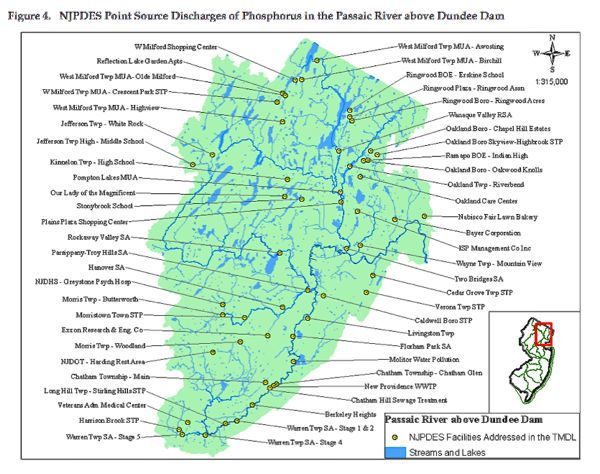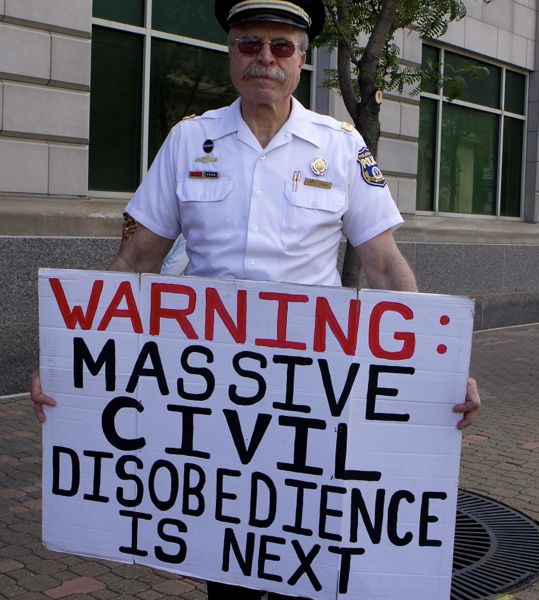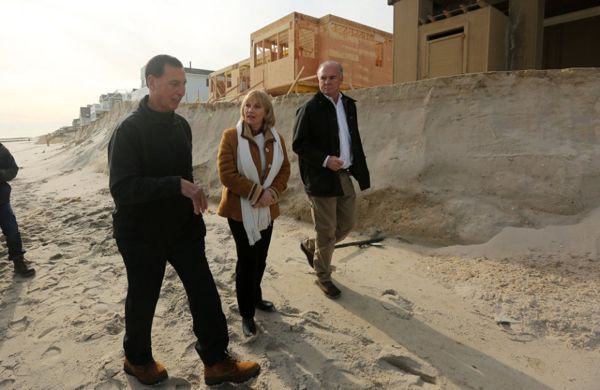More Dual Sexed Fish Documented In NJ Rivers
Chemicals Are Not Regulated, Even When Discharged Into Public Water Supplies
Not just fish and wildlife are being poisoned
[See important End Note]
The Bergen Record has an important story today on a US Geological Survey (USGS) study that found dual sexed fish in the Wallkill River and Great Swamp. (read study here).
The USGS study builds on their national water quality assessment program and prior water quality sampling work in NJ that dates to 2008 and confirms prior research. That is something you don’t learn from the Record, which creates the opposite impression, i.e that most recent USGS study is very new research. Read the whole Record story:
Male fish in two of North Jersey’s most protected areas have developed female sexual characteristics, suggesting parts of the Wallkill River in Sussex County and the Great Swamp in Morris County are contaminated with chemicals that throw hormone systems radically off.
The story should trigger public outage and calls for stronger programs to monitor and install pollution controls to reduce the discharge of these chemicals to NJ streams and rivers.
[Theo Colborn’s 1995 book “Our Stolen Future” put the issues of endocrine disruptors on the public radar screen – interested readers should hit that link for more info.]
Public outrage will ensue, especially if the public fully understands the implications of the science and the DEP’s regulatory failure to act to protect the public, which the Record story not only failed to present, but gave DEP a pass on (see map above, and this post: Warning: This Map Can Make You Sick).
New DEP regulations also should require that public water supplies install granular activated carbon (GAC) treatment systems to remove them from drinking water.
GAC is readily available and relatively inexpensive treatment technology that is very effective in removing these chemicals.
The DEP and NJ Drinking Water Quality Institute regularly evaluate the performance of and recommend installation of GAC technology as available treatment.
In fact, DEP issued a white paper on a closely related topic – which we released publicly and urged action way back in 2010, see:
Trenton — New Jersey should filter its drinking water to remove hundreds of chemicals, most of which are unregulated, from its drinking water supply, according to a rulemaking petition filed today by Public Employees for Environmental Responsibility (PEER). The plan to screen many chemicals out of tap water was actually developed by the state Department of Environmental Protection (DEP) but has been in limbo for the last six years.
State testing has detected “approximately 600” chemical compounds “in 199 samples collected” including five brands of bottled water, according to a recent DEP white paper. The vast majority of these chemicals, including pharmaceuticals, hormones, and cleaning products, are not regulated by either the federal or state government. As a result, there is no regulatory effort to reduce or eliminate them from drinking water.
The April 2010 DEP white paper, entitled “Investigations Related to a ‘Treatment-Based’ Regulatory Approach to Address Unregulated Contaminants in Drinking Water,” advocates used granular activated carbon filtration and other techniques to remove most chemicals in drinking water, noting that carbon filtration alone removed more than half of identified chemicals.
Curiously, it was the DEP spokesman – not reporter Scott Fallon or his sources – who opened the door to discussion of these critical issues with this comment in the Record story:
“How to address the fact that wastewater treatment plants don’t capture all of these chemicals before discharging their effluent remains the subject of many studies that are looking at ecological impacts, relative health risks, and potential costs of various treatment technologies,” said Larry Hajna, a DEP spokesman. ….
“The most recent USGS study adds to our knowledge of this issue and impacts to ecological systems, but the scientific community overall still has more questions than answers on human health impacts,” Hajna said.
But Record reporter Scott Fallon ignored the public health risks and drinking water issues, which is stunning, given the example right under his nose in the Passaic River.
Let’s hope he investigates and reports on those concerns in followup coverage, if only in response to what should be public outrage.
We’ve researched and witten about unregulated and endocrine disrupting chemicals several times.
Last September (2015), during the drought, we warned about how low flow in the Passaic River, used for drinking water and pumped to the Wanaque reservoir, increased the concentration of these chemicals:
… the “highly regulated activity” does not include EPA and DEP pollution discharge permit limits on all chemicals known to be present in wastewater. These chemicals pass through sewage treatment plants and are discharged to the river. They wreak havoc on aquatic life – e.g. endocrine disrupting compounds cause things like dual sexed fish – and are threats to public health. The wastewater dominated flow of chemical laced water is then taken from the river for water supply. Unless it is highly advanced – and even advanced treatment is not 100% effective in removing all chemicals present – the treatment at the drinking water plant does not remove all these chemicals, many of which are not regulated or even monitored for, and they pass through treatment directly to your tap. These are the issues DEP glosses over and downplays the risks of in the above excerpts.)
In December (2015) we warned DEP about a dual sex fish study in the Delaware River when objecting to a new sewage treatment plant on the Crosswicks Creek in Plumtsed:
Second, the sewer plant will discharge new pollution loads … and organic chemicals, including things like household hazardous chemicals, contraceptive, prescription drugs, and endocrine disrupting compounds from the metabolism of pharmaceuticals.
… most of these pollutants are toxic to plants, fish and aquatic organisms and some of the organic chemicals are causing profound ecological damage, including recentstudies that have shown “dual sexed” fish in the Delaware River.
DEP simply ignored those comment and issued the permit to the facility with no monitoring and pollution control requirements for these chemicals. There was no press coverage or outrage by environmental groups over this permit.
Prior to that, in October of 2014, we wrote to question whether DEP was serious about protecting public healh and water quality, based on a prior USGS study:
The USGS and NJ DEP have documented hundreds of unregulated chemicals in NJ rivers and over 500 in NJ drinking water supplies. These chemicals include carcinogens and human endocrine disruptors that cause serious health effects, including reproductive and behavioral problems. These chemicals impact ecosystems as well. Ecologically, the majority (>50%) of fish sampled in a recent study on the Delaware river were found to be dual sexed – male and female in the same fish.
But bowing to NJ’s powerful pharmaceutical and chemical industries who profit from these toxic chemicals, the Christie DEP is covering that up. The DEP (Governor’s Office?) even appointed and allowed a Dupont corporate official to drive the science policy question of how to regulate them – see the most recent Report of the DEP Science Advisory Board for the details of that. We have written about that scandalous abuse and been totally ignored. Instead, the press writes Big Pharma cover stories about police drug enforcement oriented collection programs.
DEP simply ignored that – again – and so did NJ press corps and NJ environmental groups.
We warned about these issues again during the EPA cleanup of Dupont’s Pompton Lakes site, see:
Finally, we predicted that the Christie DEP would take no action on these issues, a prediction that we are sorry to say has proven correct:
The new USGS National Water Quality Assessment Program data are just demonstrating the need for additional regulation of a wide variety of currently unregulated contaminants, including endocrine disruptors and pharmaceuticals widely found in rivers and drinking water – so it looks like Christie seeks to derail that effort via stealth.
[End Note: I correctly predicted that the Christie DEP would do nothing to regulate these chemicals. That prediction was not based on tarot cards, Astrology, or reading tea leaves.
That prediction was based on first hand knowledge and experience at DEP, specifically including my work on a 2002 regulatory proposal of what are called “wildlife criteria” to regulate toxic chemicals based on adverse impact on wildlife and ecosystems.
Take a look at the scandalous power the chemical industry wields with impunity. In this letter, they openly THANK DEP for gutting a major regulation.
That DEP regulatory proposal was abandoned by then DEP Commissioner Brad Campbell in response to political pressure by the chemical and pharmaceutical industry – see this for the full story, including internal DEP and industry documents:
Campbell was pro-environment and pro-regulation, but he caved to incredible industry power and abandoned the proposed new regulations.
There was virtually no public awareness, media coverage, or criticism by NJ environmental groups for that collapse. There was no political price to pay, by public officials or corporate industry interests.
So, if the Campbell DEP collapsed, it was very obvious that the pro-business and anti-regulatory Christie administration would not do anything to protect public health or the environment.
Perhaps what disgusts me most is that after all this history and all my work to discloses and warn about these risks, at subsequent scientific studies documenting he problems, STILL the media and the public and the environmental groups don’t get it.
The USGS study safely targeted the Wallkill and Great Swamp National Wildlife refuges, places where there are few industrial and sewage dischargers to blame for the pollution.
They targeted ecological effects, which prompts no real concern from the public. For example, USGS could have sampled the Passaic or Ramapo or Delaware Rivers directly upstream of drinking water intakes and included a discussion of the human health implications of those chemicals detected.
The polluters’ political power (Big Pharma and the Chemistry Council) is so strong that even US EPA has backed off their oversight of NJ DEP on these issues.
The press (Record) wrote the story in the least inflammatory and least controversial way possible and gave the Christie DEP a huge pass.
Specifically, the headline could have blared: “Study Shows That DEP Has Knows For Years That There are Unregulated Toxic Chemicals In Your Drinking Water.“
Instead, the Record swept all the prior work I’ve disclosed under the rug. They relied on lame sources who apparently know virtually nothing about the issue. They gave DEP sufficient time to provide a quote that makes it appear as if there is little prior scientific work or regulatory inaction or responsibility or failure on their part. (the DEP quote is obviously from a written statement drafted by DEP professionals, because the DEP press officers do not have the expertise to present the issues like that orally on their own. This means Fallon gave DEP plenty of time to respond to and spin the USGS study.)
It’s not the first time Scott Fallon and the Bergen Record have done this cap.
They do their readers a grave disservice in failing to write the real story and hold public officials, DEP, and corporate polluters accountable.
Finally, I must note that NJ environmental groups have largely abandoned this kind of traditional meat and potatoes work on clean water, DEP regulation, and facility permits, and public health risks from toxics.
The abandonment began long ago (see: Clean Water Anyone?) – no one showed up!
Environmental groups have been manipulated by Foundation grant money that has diverted them from these controversial issues and instead been funded to work on politically safe issues that don’ threaten powerful chemical and pharmaceutical industries and their friends in State government, like sustainability, the Delaware Watershed (Wm Penn and Dodge Foundations) and the Dodge Foundation funded “The Raritan Initiative”, which Rutgers has shamefully joined as well.
You simply do not see well informed and hard hitting critiques like this anymore – they have been defunded by the Foundations and abandoned by the environmental groups.









